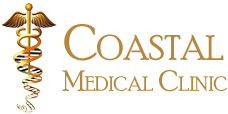Free Health Articles by Dr. Smolenski ::. Myrtle Beach, SC
Estrogen Dominance
This condition occurs when your estrogen levels are normal but your progesterone levels are suppressed. The symptoms and conditions associated with estrogen dominance are:
- Acceleration of the aging process
- Breast cancer
- Breast tenderness
- Cold hands and feet as a symptom of thyroid dysfunction
- Decreased sex drive
- Depression with anxiety or agitation
- Fat gain, especially around the abdomen, hips and thighs
- Fatigue
- Foggy thinking
- Hair Loss
- Increased blood clotting (increasing risk of strokes)
- Irritability
- Insomnia
- Memory loss
- Mood swings
- Osteoporosis
- Sluggish metabolism
- Water retention, bloating
Progesterone acts as an antagonist to estrogen. For example, estrogen stimulates breast cysts while progesterone protects against breast cysts. Estrogen enhances salt and water retention while progesterone is a natural diuretic. Estrogen has been associated with breast and endometrial cancers, while progesterone has a cancer preventive effect. Studies have shown that pre-menopausal women who were deficient in progesterone had 5.4 times the risk of breast cancer compared to healthy women.
Estrogen and progesterone work in synchronization with each other as checks and balances to achieve hormonal harmony in both sexes. It is not the absolute deficiency of estrogen or progesterone but rather the relative dominance of estrogen and relative deficiency of progesterone that is main cause of health problems when they are off balance.
While sex hormones such as estrogen and progesterone decline with age gradually, there is a drastic change in the rate of decline during the peri menopausal and menopausal years for the women in these two hormones as mentioned earlier. From age 35 to 50, there is a 75% reduction in production of progesterone in the body. Estrogen, during the same period, only declines about 35%. By menopause, the total amount of progesterone made is extremely low, while estrogen is still present in the body at about half its pre-menopausal level.
With the gradual drop in estrogen but severe drop in progesterone, there is insufficient progesterone to counteract the amount of estrogen in our body. This state is called estrogen dominance. Many women in their mid-thirties, most women during peri-menopause (mid-forties), and essentially all women during menopause (age 50 and beyond) are overloaded with estrogen and at the same time suffering from progesterone deficiency because of the severe drop in physiological production during this period. The end result - excessive estrogen relative to progesterone, a condition we called estrogen dominance.
Common Estrogen Dominance Conditions
- Endometriosis
- Premenstrual Syndrome (PMS)
- Fibrocystic Breast
- Pre-menopausal Syndrome
- Polycystic Ovary Syndrome (PCOS)
- Fibroids
- Breast Cancer
Reducing your external estrogen load is a key component that everyone should follow. Start with your home with the following:
- Throw away all pesticides, herbicides, and fungicides.
- Throw away cosmetics that have toxic ingredients and switch to estrogen-free cosmetics.
- Don't use fabric softeners as it puts petrochemicals right on your skin.
- Use only naturally based perfumes. Most perfumes are petrochemically based.
- Have a good water filter for your source of water.
- Do not use plastic goods since all plastic leaches estrogens into the environment.
- Try to eat only organic based whole foods.
- Avoid surfactants found in many condoms and diaphragm gels.
- Do not microwave food in plastic containers, and especially avoid the use of plastic
wrap to cover food for microwaving.
- Wash your food well to rid the pesticides.
A weight loss program will help decrease your symptoms of estrogen dominance as will a healthy diet and exercise program. Usually I treat estrogen dominance with bio-identical progesterone and also add some supplements that help balance the progesterone to estrogen ratio.
